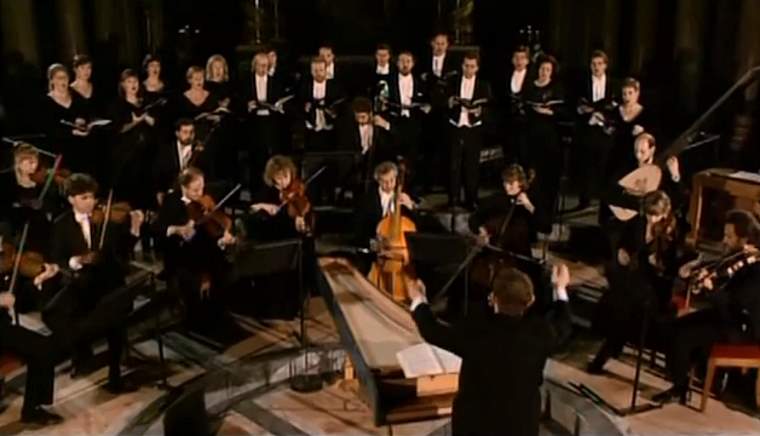Vivaldi’s Women (Schola Pietatis Antonio Vivaldi) in an all-female performance of the Gloria at the Church of the Pietà in Venice. The tenors and basses are in the north cantoria (organ side, right) with the sopranos and contraltos facing them on the left. The orchestra (the Orchestra of the Age of Enlightenment/Jerwood Experience) is in the west gallery. Costumes by Eric Doughney, after Grevenbroeck.
Antonio Vivaldi’s Gloria
Antonio Vivaldi’s “Gloria” in D major, RV 589, is one of the most popular pieces of sacred music from the Baroque period, celebrated for its vibrant energy, expressive melodies, and distinctive choral and orchestral writing. Composed probably around 1715 during Vivaldi’s tenure at the Pio Ospedale della Pietà, an orphanage for girls in Venice, the work is a shining example of Vivaldi’s ability to infuse traditional liturgical music with his characteristic vivacity and melodic inventiveness.
The “Gloria,” a setting of the traditional “Gloria in Excelsis Deo” text from the Latin Mass, is structured in twelve movements, each varying in style and mood, yet collectively forming a cohesive and compelling whole. This structure allows Vivaldi to explore a wide range of emotions, from jubilant praise to profound contemplation.
- Gloria in Excelsis Deo: The opening chorus is bright and lively, characterized by its energetic rhythms and joyful melody. This movement sets the tone for the entire work, with its celebratory mood and vibrant orchestration.
- Et in Terra Pax: Contrasting the exuberant opening, this movement is more subdued and lyrical, reflecting the text’s plea for peace on Earth. The music here is introspective, with rich harmonies and expressive choral writing.
- Laudamus Te: This duet for two sopranos is light and dance-like, featuring intricate vocal lines and a playful interplay between the soloists and the orchestra.
- Gratias Agimus Tibi: A brief choral movement that serves as a transition, it’s characterized by its solemn and respectful tone.
- Propter Magnam Gloriam: This movement returns to the jubilant mood of the opening, with the choir and orchestra engaging in a lively and rhythmic celebration.
- Domine Deus: A soprano solo, this section is lyrical and serene, featuring a beautiful, flowing melody that showcases the soloist’s expressiveness.
- Domine Fili Unigenite: A joyful and energetic choral movement, it’s marked by its brisk tempo and vivacious rhythms, echoing the exultant mood of the opening.
- Domine Deus, Agnus Dei: This movement, a duet for alto and chorus, is more somber and reflective, with the alto soloist pleading for mercy and peace.
- Qui Tollis Peccata Mundi: A chorus that continues the penitential mood of the previous movement, it’s characterized by its contrapuntal lines and expressive dynamics.
- Qui Sedes ad Dexteram Patris: An alto solo, this movement is introspective and contemplative, featuring a lyrical melody that conveys a sense of deep devotion.
- Quoniam Tu Solus Sanctus: Returning to a brighter mood, this movement is a lively chorus with a triumphant character, celebrating God’s holiness.
- C. Sancto Spiritu: The final chorus is a grand and exuberant conclusion to the work, characterized by its vigorous rhythms and jubilant melody, echoing the celebratory mood of the opening.
Throughout the “Gloria,” Vivaldi’s mastery of vocal and orchestral writing is evident. He skillfully balances solo and choral sections, creating a dynamic interplay between the different voices and the orchestra. The result is a work that is rich in contrast and variety, yet unified by Vivaldi’s distinctive melodic style and rhythmic vitality.
Vivaldi’s “Gloria” RV 589 remains a staple in the choral repertoire, beloved for its melodic beauty, emotional range, and the exuberant spirit that Vivaldi brings to the sacred text. It is a work that continues to inspire and uplift audiences, embodying the joy and reverence at the heart of Baroque sacred music.
Vivaldi’s Women (Schola Pietatis Antonio Vivaldi)

Vivaldi’s Women is an all-female ensemble of singers and players founded in 2005, initially to research and make programs for BBC television and radio about Vivaldi’s life and work at the Ospedale della Pietà in Venice. It also performs, records, and produces editions of music by Vivaldi and his colleagues. Vivaldi’s Women aims to recreate the sound of the Figlie di Choro, foundling girls, and women who performed at Mass and Vespers hidden from view behind grilles in the high choir galleries.
It reflects the age range (14-70) and musical tradition of the original musicians, some singing tenor, and bass (at pitch), and others playing forgotten instruments, recreating an exotic soundscape of 18th-century Venice. Its work is based on the findings of Vivaldi historian Micky White, which gives us a comprehensive picture of the daily life of this remarkable institution during its musical heyday.
Vivaldi wrote at least three settings of the hymn Gloria in excelsis Deo and two survive: RV 588 and RV 589. A third, RV 590, is mentioned only in the Kreuzherren catalog and presumed lost. RV 589 Gloria is a familiar and popular piece among sacred works by Vivaldi. It was probably written at about the same time as the RV 588, possibly in 1715.
RV 589 is the best-known setting of the Gloria, simply known as the Vivaldi “Gloria” due to its outstanding popularity. This piece, along with its mother composition RV 588, was composed at the same time during Vivaldi’s employment at the Pieta.
Sources
- Vivaldi’s Women (Schola Pietatis Antonio Vivaldi) on LinkedIn
- Gloria (Vivaldi) on Wikipedia
- Pavarotti sings Pourquoi me réveiller [Massenet] at the Central Park in 1993 - April 23, 2024
- Elgar: Serenade for Strings [Concertgebouw Chamber Orchestra] - April 19, 2024
- Mozart: Serenade No. 10 “Gran Partita” [MET Orchestra Chamber Ensemble] - April 18, 2024

